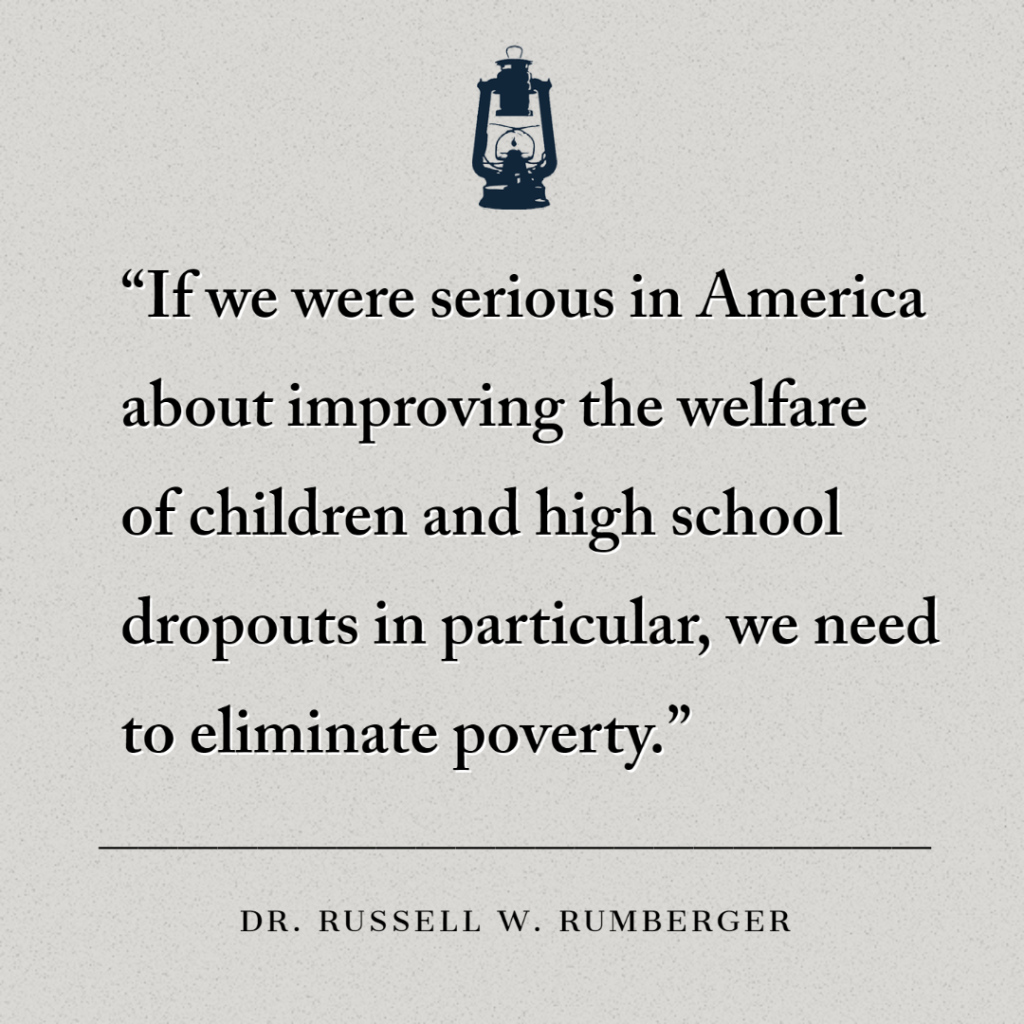Cynthia Montserrat Arellanes
Contributing Writer
Russell W. Rumberger is a professor emeritus at the Gevirtz Graduate School of Education where he taught for over 25 years. He received a Ph.D. and an M.A. in education from Stanford University and a B.S. in electrical engineering from Carnegie Mellon University. Throughout his extensive career, his research focused on school dropouts, the economics of education, and linguistic minorities. He worked on California state policy, which focused on high school completion and authored, “Dropping Out: Why Students Drop Out of High School And What Can be Done About It,” published in 2011 by Harvard University Press. The book examines why students drop out of school and addresses preventative measures and contributing factors to student success and shortcomings. In an interview with The Bottom Line, we reconnected with Dr. Rumberger and asked him to share about the communities he researched and ongoing factors that contribute to students’ academic future.
Responses have been lightly edited for clarity.
What personal experiences influenced your decision to study school dropouts?
“I came to the realization that school dropouts are the population most disadvantaged. At Stanford, my advisor Henry Levin focused his research on the economy and education of those who were disadvantaged. It wasn’t long before I became interested in conducting research with school dropout populations. He influenced my academic trajectory. Working with him on research projects, I became interested in disadvantaged students and essentially, that is what drove me to go into the field of education.”
How do you define school dropouts in your research?
“In a book I published in 2011 titled, “Dropping Out,” I have a chapter dedicated to how you define school dropouts. There are technical and conceptual definitions, but essentially it is students who interrupt their schooling for an extended period of time. I say interrupted because some dropouts do come back to school, but others do not. The common denominator is students withdraw, and at some point, they stop attending school.
Sometimes for short periods of time, others drop out indefinitely, which makes defining it and measuring school dropouts challenging. If students drop out for a short period of time, it may not be picked up by any indicators or the metrics that are used to measure school dropouts. The metrics can miss the students who have shortened spells of withdrawal. Essentially school dropouts are defined as students who are withdrawn from the K-12 pathway, who do not graduate high school. They have left school or don’t attend school. You can formally withdraw from school or not show up.”
“Environmental factors, school, families, and communities are a powerful predictor in some ways more than students’ own behaviors and achievements.”
What factors contribute to students dropping out?
“You can look at individual factors that contribute to dropping out such as students failing classes. Students who fail their courses are not receiving credit and therefore are not going to graduate — at least on time. We also have the category of students who have behavior issues. There is literature and interest in the issue of suspension and expulsion, and there are clear equity issues surrounding the subject. There are those kinds of factors.
We also have factors of absenteeism that is a direct correlate of dropping out. Students who are withdrawing from schools typically skip classes and skip school. These categories of individual factors are probably more immediately understandable to people. But there are many categories of contextual factors that look at the characteristics of students’ families, the schools students attend, and communities they live in as contributing. I’ve done a couple of papers and there are several studies that show that a student’s school environment is a more powerful predictor of their success or failure than their family environment, which is the one that we tend to immediately think about. A student’s family’s socioeconomic status is highly correlated with success in education. However, I did some studies and analyses (others have too), and we found that the social-economic status of the school students attend is a strong indicator of student achievement.
We have very segregated schools in America and some schools are more problematic for students than others in terms of resources. In particular, what has been shown in the literature is that the social-economic composition of the school influences the students’ success or failure. It can be a correlate of school resources such as quality of resources, number of teachers and staff, or even the influence of other students and peers who can influence your focus on education. Environmental factors, school, families, and communities are more powerful predictors in some ways than students’ own behaviors and achievements.”
What changes do you believe need to happen to positively impact the future of our education system?

“Eliminate poverty. Poverty affects everything; it affects family welfare, mental health, and homelessness. Several years ago, I wrote a piece about the relationship between poverty and dropouts for the American Psychology Association. Poverty is pervasive and the pandemic is just exacerbating those things. People are getting evicted, going hungry. Let’s analyze the tax medical system that we have. If we were serious in America about improving the welfare of children and high school dropouts in particular, we need to eliminate poverty so no family is impoverished.”
In your leisure time, what activities do you enjoy?
“A couple years ago, I became very interested in learning more about my family history. I’ve become very interested in genealogy and have discovered some interesting facts. My mother is British and she met my father during World War 2, so she immigrated to America in 1946. I actually discovered records of the boat she was a passenger on.
In regards to my father’s side of the family, I discovered that my fourth great grandfather immigrated to the United States in 1753. Within my family, I have two different eras of immigrants. My father’s background is German, and I also found out that I have Irish ancestors who were Quakers and they came to America in 1723. I discovered that they started a church or as they call them, “friends.” After doing some research, I found that my fourth great grandfather helped build it and I discovered that not only is the building still standing, but also that it is still a practicing Quaker church. It was built more than 200 years ago!”











